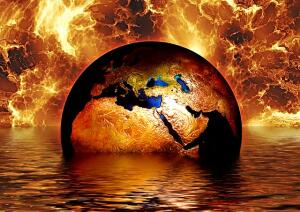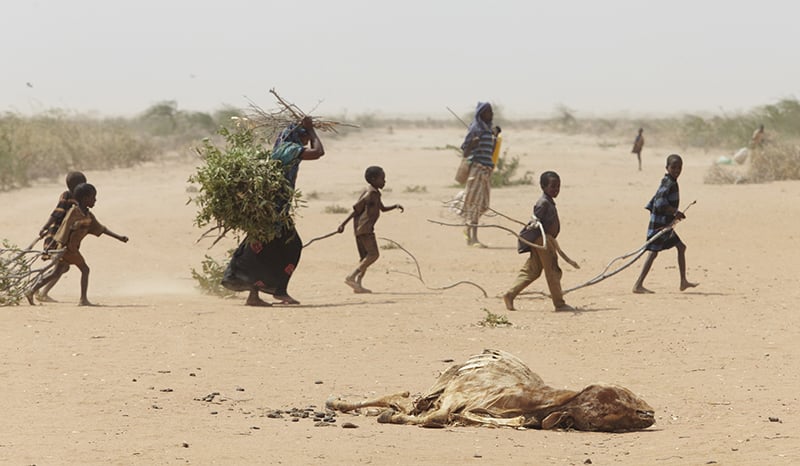 It's been as cold as Mars in the eastern United States. Should that make us doubt the existence of a warming planet? After all, seeing is believing.
It's been as cold as Mars in the eastern United States. Should that make us doubt the existence of a warming planet? After all, seeing is believing.
The scientific community has come to an overwhelming consensus (97 percent of actively publishing climate scientists agree) that global warming is real and is caused by human activities. Yes, there are deviations from the warming trend, such as this year's eastern freeze, and when that happens, it's hard for the average person to believe climate change is real. But cold "weather" and a changing "climate" are two different things entirely.
With that in mind, we've gathered 10 visual examples that show how climate change is impacting the planet.
Agricultural Failure and World Hunger
Many places around the globe are seeing an extreme dearth of moisture due to climate change. This is especially prominent and devastating in poor African communities where most people are subsistence farmers. For them, heat waves and drought don't just threaten their livelihoods, they also threaten their lives.
The 2011 East Africa drought, and the more recent 2015-2016 drought and floods in Malawi and Mozambique, serve as a poignant reminders of the effects that climate change, global warming, and humans have on the earth and our fellow inhabitants.

A family outside of Dadaab, Kenya gathers sticks to build a shelter in July of 2011. The drought brutally affected the land, the animals, and the people. Photo by Andy Hall of Oxfam East Africa.

In the Dadaab refugee camp, a young girl stands among the graves of children who perished during the famine. Photo by Andy Hall of Oxfam East Africa.
Glacier Retreat
The overall warming of the Earth can readily be seen through glacier retreat. As the greenhouse effect strengthens, the world's glaciers melt away. Below are a few examples of glaciers that have shrunk substantially in size since the Industrial Revolution.
The comparisons are photos of the same glaciers, taken from the same position and at the same time of year, but many years apart.
Lyell Glacier - Yosemite National Park - California

To learn more about glaciers in Yosemite, click here.
McCarty Glacier - Kenai Fjords National Park - Alaska

To learn more about glaciers in the Kenai Fjords, click here.
Coral Reef Bleaching and Ocean Acidification
The warmer atmosphere and the melting of glaciers feed into the warming of the ocean. Given the rapid temperature increase caused by human activities, oceanic creatures are struggling to adapt. This leads to coral reef bleaching and ocean acidification.
Coral Bleaching
Coral is very sensitive to temperature change. As the seas' temperatures rise, the coral loses its food, zooxanthellae. This nutrient is what gives the coral its color; so, as it dissipates, the coral turns white. This process is known as coral bleaching.

Coral bleaching at Heron Island, Australia in 2014. Photo by The Ocean Agency/XL Catlin Seaview Survey/Richard Vevers.

Coral bleaching at the Florida Keys, USA in 2014. Photo by Kelsey Roberts, USGS.
Ocean Acidification
The ocean absorbs much of the gas that is released into the atmosphere. As higher levels of greenhouse gases enter the atmosphere, higher levels are absorbed by the ocean. The problem lies with the excessive absorption of CO2, which causes a change in the pH balance - it makes the water more acidic. The extra acidity makes it more difficult for corals to take in needed calcium carbonate.

Fish try to find shelter in a bleached Great Barrier Reef coral at the Keppel Islands, Australia in 2011.
Coral bleaching and ocean acidification don't just harm the corals, they also spell danger for the hundreds of thousands of fish, clams, prawns, and other creatures that use the corals as their homes.
Learn more about the effect of climate change on coral reefs here.
Increasing Crop Pests and Diseases
Humans have been fighting crop pests and diseases since intentional cultivation began. They're not new, but they are a bigger problem now than they have ever been. Crop pests and diseases have started to creep up in new areas - areas that are usually cold enough to kill the invaders before they can take hold. Scientists have found a correlation between global warming and this increase.
Late Blight

Unripe tomatoes infected with late blight. Late blight was the cause of the famous Irish Potato Famine, but it still destroys about 6 billion dollars' worth of crops each year (source). Photo by Scot Nelson.
Stem Rust

Wheat covered in stem rust. Stem rust is a fungus that grows on cereal crops like wheat, barley, and triticale, and has a history of destroying U.S. crops. Photo by IAEA Imagebank.
Colorado Potato Beetle

The Colorado Potato Beetle has been a major pest for hundreds of years. As the global temperatures rise, the spread of this beetle and the destructive power it brings becomes much more far reaching. Photo by Dwight Sipler.
Continuing the Fight

While the negative effects of climate change are peeking through, it's also important to remember the people, companies, communities, and countries committed to protecting and healing the environment.
One way that you can help protect the environment is by saving resources whenever you can, including donating your used and unwanted textiles. Find a Planet Aid donation bin near you today!
If you would like more visual reminders of climate change, follow Everyday Climate Change on Instagram.
Global Warming
Climate change is attributed to global warming, and global warming is attributed to the greenhouse effect. While the greenhouse effect is natural, the amount of gas currently trapped in the atmosphere is not. The more greenhouse gas that's in the atmosphere, the warmer the earth becomes. This is where there's a problem, and it's very clear that this problem is caused by human activity.
One greenhouse gas that demonstrates the human impact on climate change is carbon dioxide (CO2). The amount of CO2 in the atmosphere has increased by more than a third since the Industrial Revolution (source). The graph below shows the historical amount of CO2 in the atmosphere and the rapid increase caused by human civilization.
 This graph's historical figures are based on atmospheric samples contained in ice cores. The recent figures have been directly measured. Learn more about ice cores here.
This graph's historical figures are based on atmospheric samples contained in ice cores. The recent figures have been directly measured. Learn more about ice cores here.
i
